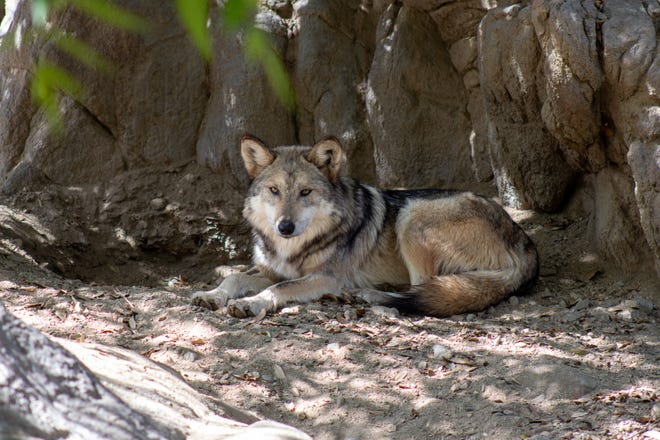Mexican gray wolf at California zoo is recovering after leg amputation: 'Huge success story'
Soleil Ellen, a Mexican gray wolf who came to the Living Desert Zoo and Garden in April, is on the mend after her fractured leg was amputated last week.
 Eric Lagatta
Eric Lagatta
A Mexican grey wolf is recovering at a zoo in California's Coachella Valley after veterinarians had no choice but to amputate one of the animal's legs when it fractured it while jumping.
The procedure was completed Wednesday, Nov. 29 shortly after the female wolf, a relative newcomer to the Living Desert Zoo and Gardens in Palm Desert, fell and landed awkwardly in her enclosure.
Such injuries are not uncommon among the species of wolf, who are known for their high jumps and rough play. The wolf, named Soleil Ellen, faces up to two weeks of recovery before zoo officials think she can rejoin her pack.
"Soleil Ellen is quickly recovering and adapting to this challenge as well as have others of her species," Allen Monroe, Living Desert Zoo and Gardens president and CEO, said in a statement. "She will soon return to her habitat and pack mates where she can serve as an ambassador to popularize the huge success story of the endangered Mexican Wolf."
Shih Tzu rescued:Video shows elderly 17-year-old Shih Tzu rescued from air vent in Virginia home: Watch
What is the Mexican gray wolf?
The smallest gray wolf subspecies in North America, the Mexican gray wolf was nearly wiped out by the 1970s in an effort to protect them from killing livestock.
Once common throughout parts of the southwestern U.S. and Mexico, the Mexican grey wolves are now considered to be one of the rarest – and most imperiled – mammals on the planet, according to the Center for Biological Diversity.
The species was saved from the brink of extinction in 1976 when it became one of the first to be marked for protection after the passage three years earlier of the Endangered Species Act. By 1980, the last known Mexican gray wolf survivors had been captured to be bred in captivity.
This year, in fact, marks the 25th anniversary of the reintroduction of Mexican wolves to the wild in the United States, according to the U.S. Fish & Wildlife Service. In 1998, the agency released the first captive Mexican wolves back into Arizona and New Mexico.
As of 2022, a minimum of 241 Mexican wolves were believed to be spread across southwest New Mexico and southeast Arizona after their population had been increasing for seven consecutive years, according to the Fish & Wildlife Service.
Shark attack:Mexican woman killed in shark attack while swimming with 5-year-old daughter
Soleil Ellen will soon rejoin her wolf pack

Soleil Ellen, a 3-year-old Mexican gray wolf, joined the Living Desert zoo in April, where she lives with a pack of two other males.
After the wolf's injury, the Living Desert's veterinary team evaluated her and found that she sustained a mid-shaft spiral fracture of her right humerus. The medical team consulted with the Fish & Wildlife Service, as well as the Association of Zoos and Aquariums’ Mexican Wolf Species Survival Plan to decide on what course of treatment to take.
While the team considered surgery and casting with pins and wires, they were concerned about the lengthy recovery process that would limit the wolf's movements too long, causing undue stress. The active wolf species is one rarely at rest, making bedrest improbable, said Andrea Goodnight, the zoo's head veterinarian.
Now that the procedure was completed last week, it won't be long until Soleil Ellen will be able to rejoin her pack. Zoo officials estimated that she will have recovered enough to integrate back into her habitat within one to two weeks, followed by several weeks of additional recovery.
The wolf is also being closely monitored post-surgery and is receiving pain medication to alleviate any discomfort.
"Considering the limitations and months-long recovery period required for other treatments, an amputation was the best choice for Soleil Ellen’s mental and physical wellbeing," Goodnight said in a statement. "This procedure will have minimal to no effect on her future and will allow her to resume normal activities with her pack as soon as possible.”
Eric Lagatta covers breaking and trending news for USA TODAY. Reach him at elagatta@gannett.com
